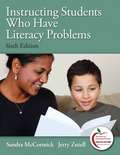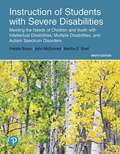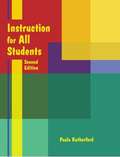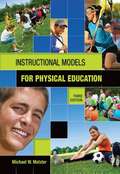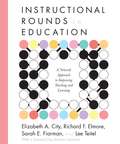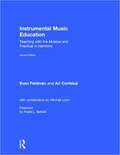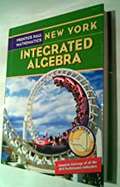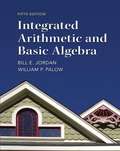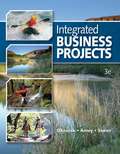- Table View
- List View
Inspiring Connections Course 1, Mathematician’s Notebook, Volume 1
by Mark Ray Gail Anderson Ernesto BautistaNIMAC-sourced textbook
Inspiring Connections Course 1, Mathematician’s Notebook, Volume 2
by Mark Ray Gail Anderson Ernesto BautistaNIMAC-sourced textbook
Inspiring Connections Course 1, Mathematician’s Notebook, Volume 3
by Mark Ray Gail Anderson Ernesto BautistaNIMAC-sourced textbook
Inspiring Connections Course 3, Mathematician’s Notebook, Volume 1
by Mark Ray Gail Anderson Ernesto BautistaNIMAC-sourced textbook
Inspiring Connections Course 3, Mathematician’s Notebook, Volume 2
by Mark Ray Gail Anderson Ernesto BautistaNIMAC-sourced textbook
Inspiring Connections Course 3, Mathematician’s Notebook, Volume 3
by Mark Ray Gail Anderson Ernesto BautistaNIMAC-sourced textbook
Inspiring Insects (Fountas & Pinnell Classroom, Guided Reading)
by Noelle ChildNIMAC-sourced textbook. Nature's Tiny Marvels. The technology of the future is coming as scientists and engineers get new ideas from nature's tiniest technological marvels: bugs!
Instructing Students Who Have Literacy Problems (6th edition)
by Jerry Zutell Sandra MccormickThis research-based book on assessment and instruction of struggling readers covers both assessment and instructional strategies and reflects a balanced view of literacy instruction. Four complete chapters on formal and informal assessment, plus chapters on instructional interventions, including reading instruction for special populations, allow professors the option of using the book for one inclusive course, or, using it across two courses where diagnosis and instruction are taught separately.
Instruction Manual for Braille Transcribing
by Constance Risjord Library Of Congress National Library Service for the Blind Physically Handicapped StaffThe courses leading to certification as a braille transcriber or proofreader have been administered by the National Federation of the Blind (NFB) under a contract with and on behalf of the National Library Service for the Blind and Physically Handicapped, Library of Congress (NLS).
Instruction Of Students With Severe Disabilities
by Fredda Brown John McDonnell Martha SnellIn this authoritative guide, leading scholars and researchers present information and evidence-based practices for dealing with the full range of curriculum and instruction for individuals with severe intellectual disabilities and autism. Case studies throughout Instruction of Students with Severe Disabilities look at students of various ages and with a variety of disabilities, and each chapter includes an application to a student with autism. The content is presented with citations of supportive research, and evidence-based practices are presented in clearly defined ways to ensure that teachers understand the practices and how to apply them in their own classrooms.
Instruction for all Students: Second Edition
by Paula RutherfordThe second edition of this popular book is updated to reflect current research about best practice in teaching and learning in standards-based classrooms. In addition to resources for actively engaging students and multiple approaches to lesson and unite design, this text includes information on technology integration, formative assessment, 21st century thinking skills that promote rigor and relevance, and formats for job-embedded learning.
Instructional Models in Physical Education (Third Edition)
by Michael W. MetzlerInstructional Models for Physical Education has two primary goals for its readers. The first is to familiarize them with the notion of model-based instruction for physical education, including the components and dimensions that determine a model's pattern of teaching and how to select the most effective model for student learning in a particular unit. The second goal is to describe each of the instructional models in such a way to give readers enough information to use any of the models with confidence and good results. <p><p> The book includes everything readers will need for planning, implementing, and assessing when teaching with instructional models. It will help readers incorporate research-based practices in their lessons, adapt activities to include students of varying abilities, and teach to standards. <p> The author has revised the third edition to show how using the instructional models can help teachers meet specific NASPE standards. The book demonstrates the connection of NASPE standards with the models and clarifies that connection for students. In addition, a table in each of the model chapters shows explicitly how the model aligns with NASPE standards.
Instructional Rounds in Education: A Network Approach to Improving Teaching and Learning
by Elizabeth A. City; Richard F. Elmore; Sarah.E. Fiarman; Lee TietelWalk into any school in America and you will see adults who care deeply about their students and are doing the best they can every day to help students learn. But you will also see a high degree of variability among classrooms—much higher than in most other industrialised countries.
Instrumental Music Education: Teaching with the Musical and Practical in Harmony
by Evan Feldman Ari Contzius<p>Instrumental Music Education: Teaching with the Musical and Practical in Harmony, 2nd Edition is intended for college instrumental music education majors studying to be band and orchestra directors at the elementary, middle school, and high school levels. This textbook presents a research-based look at the topics vital to running a successful instrumental music program, while balancing musical, theoretical, and practical approaches. A central theme is the compelling parallel between language and music, including "sound-to-symbol" pedagogies. Understanding this connection improves the teaching of melody, rhythm, composition, and improvisation. <p>The companion website contains over 120 pedagogy videos for wind, string, and percussion instruments, performed by professional players and teachers, over 50 rehearsal videos, rhythm flashcards, and two additional chapters, "The Rehearsal Toolkit," and "Job Search and Interview." It also includes over 50 tracks of acoustically pure drones and demonstration exercises for use in rehearsals, sectionals and lessons.</p>
Insurance Law: Cases and Materials (Third Edition)
by Roger C. HendersonThis Third Edition includes many new cases and notes, as well as a thorough revamping of a number of sections and chapters. For example, Chapter 2 now brings together materials on fundamental assumptions of insurance law. A new Chapter 3 brings together a variety of materials on both judicial and legislative regulation of the insurance business. The authors designed this edition towards three primary goals: (1) To impart an understanding of basic insurance law through the cases and notes; (2) To raise fairly debatable, provocative issues, which will involve students in legal analysis and resolution; (3) To inform students about basic insurance business practices, as well as some of the more practical problems faced by attorneys, judges, and insurance regulators in the real world. The overall aim is to impart a sound foundation in law and legal analysis, an understanding of the business of insurance, and an appreciation of the role of insurance in modern society. The book is designed for either a three- or four-hour course in insurance law, but through some judicious editing it may also be used in a two-unit course.
Insurance Planning
by James F. Dalton Michael A. Dalton Thomas P. Langdon Joseph M. GilliceThis book is written for undergraduate and graduate level students interested in acquiring an understanding of financial planning from a professional financial planning viewpoint. The text is intended to be used in an overall curriculum in financial planning in an Insurance course or in a course that combines Fundamentals of Financial Planning and Insurance.
Integrated Algebra (NY Edition)
by Randall I. Charles Allan E. Bellman Sadie Chavis Bragg Basia Hall Dan Kennedy William G. HandlinAlgebra textbook
Integrated Arithmetic and Basic Algebra (5th Edition)
by Bill E. Jordan William P. PalowIntegrated Arithmetic and Basic Algebra, Fifth Edition, integrates arithmetic and algebra to allow students to see the big picture of math. Rather than separating these two subjects, this text helps students recognize algebra as a natural extension of arithmetic. As a result, students see how concepts are interrelated and are better prepared for future courses.
Integrated Business Projects
by Wylma Skean Anthony A. Olinzock Janna ArneyMaster computer skills in a business scenario setting with INTEGRATED BUSINESS PROJECTS! Coverage includes main software applications, calendaring, and desktop publishing. Technology tips provide shortcuts and helpful hints. Students have fun while mastering the computer applications needed to succeed in today's business world!

